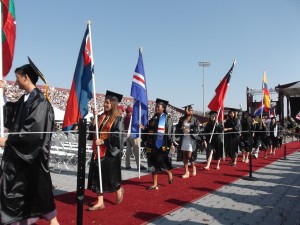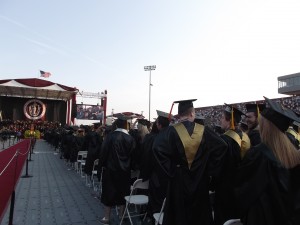I attended a talk tonight at the Haston Library by Octavia Taylor, whom I knew from when I worked at Clark University; she graduated from Clark with a master’s degree in International Development in 1993. Her topic was “Life in Palestine” so I thought it would be interesting to hear about what has been happening there recently. The talk seemed rather timely, as I am in the middle of reading a compilation of journalism pieces on the Mideast and North Africa which were written almost twenty years ago. “Palestine” isn’t listed as one of the countries covered in the book, so maybe it comes up in the chapter on Israel (I haven’t gotten to that one yet). When I thought about the past two decades, I wondered if conflict is endemic in the Middle East, or if there’s hope for peace. Perhaps I will find out tonight, I thought, as I made my way to the library.
About 20 of us gathered in the library reading room where a screen was set up for the Power Point slide presentation. Ms Taylor began by telling us that she and her husband are mostly retired now and wanted to do something with their time that involved travel and the Middle East (they had lived in Syria and the Emirates for a few years previously, and Octavia had bicycled through the area). So her husband took a job teaching at Birzeit University, and she worked with Jeff Halper, Co-Founder and Director of the Israeli Committee Against House Demolitions. In the fall of 2014, the couple lived in Ramallah in the West Bank and traveled around the region.
Ms Taylor showed slides of the people and places she came to know: monasteries (many called St George), ancient cities like Jericho, Jerusalem, Hebron, and Bethlehem, terraced wineries, olive groves with two hundred-year-old trees, spice markets, Bedouin camps, cafes and food stalls selling falafel, the national dish. The families she met were friendly and hospitable; many were deeply attached to their traditions and heritage (Ms. Taylor brought with her an exquisitely embroidered handbag, which I would have loved to own).
The modern history of Palestine is stark: following World War I, the British were awarded the mandate to govern the region; tiring of this responsibility after World War II ended, Britain opted out, and in November 1947, the UN adopted Resolution 181 recommending partition into an Arab state, a Jewish state, and the City of Jerusalem. After the 1948 war, Israel captured and incorporated more territory than was allocated by the UN; Jordan got Judea and Samaria which became known as the West Bank; and Egypt got the Gaza Strip. In this war, entire villages were destroyed and 750,000 Palestinians found themselves homeless. In the Six-Day War of 1967, Israel defeated both Jordan and Egypt and completed the acquisition of the land originally allocated to the Arab state.
The 1993 Oslo Accords were an attempt at an agreement on the principles which would lead to the resolution of the Israeli-Palestinian conflict. In terms of land, three types of territory were acknowledged: land (A) under full Palestinian Authority control (18% of the West Bank), (B) under Palestinian Authority civil control (22% of the West Bank), and (C) under full Israeli control (60%). Thus, the total land area that was supposed to become the new Palestine was far smaller than it was in 1948, and Palestinians living in areas (B) and (C) ended up living under Israeli occupation. This has been a disaster for Palestinians.
For Palestinians, living in the Occupied Territories means red signs, walls, guard towers, checkpoints, Israeli roads, demolition of their homes, and Jewish settlements and outposts on formerly Palestinian land. In addition, refugee camps established in 1948 and administered under the UNRWA, United Nations Relief and Works Agency [for Palestine Refugees], still exist. In fact, Gaza hosts eight camps with a population of 1.2 million, while the West Bank has nineteen camps holding 741,400 refugees. For those living in these camps, UN Resolution 194, which discusses the right of return in Section 11, probably seems like a pipe dream.
The perceptions of “the other” on both sides are actually very similar, and similarly distorted. So is there any hope for resolution of this conflict? Ms Taylor reported on what might be called “resistance movements”: there are organizations like the Women in Black Movement which defies government restrictions on fraternizing with the enemy; there are courageous individuals who open museums and create art works; there are groups who start businesses and create cities like Rawabi; there is the attempt by the BDS (boycotts, divestment, sanctions) movement to foster international condemnation of Israel.
Ms. Taylor urged us to educate ourselves on the Israeli-Palestinian conflict, so I picked up some literature on my way out. By chance, for Book Club this month our group is reading a novel which discusses the Good Friday Agreement of April 1998, which ended the Troubles in Northern Ireland, but I am now wondering if more than masterly diplomacy is needed in the Middle East.

